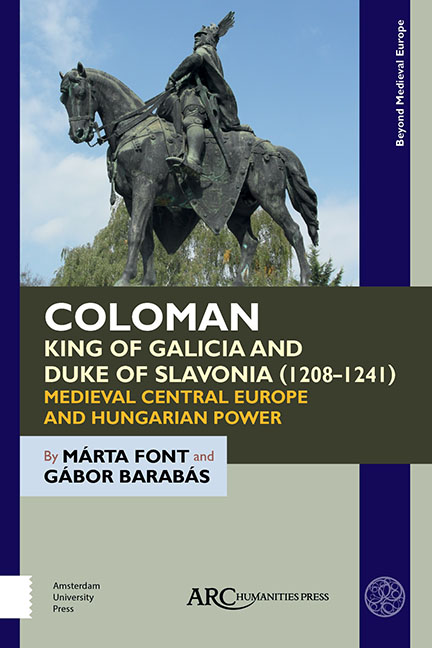 Coloman, King of Galicia and Duke of Slavonia (1208–1241)
Coloman, King of Galicia and Duke of Slavonia (1208–1241) Book contents
- Frontmatter
- Contents
- List of Illustrations
- Foreword
- Introduction
- PART ONE COLOMAN AS CHILD RULER OF GALICIA
- Chapter 1 The Galician Context in 1205
- Chapter 2 The Agreement of Scepus
- Chapter 3 Coloman’s Coronation as King of Galicia: Date and Place
- Chapter 4 The Hungarian Elite and Coloman’s Court
- Chapter 5 Coloman’s Position in Halych, 1215–22: Campaigns and Opponents
- Chapter 6 Upholding the Galician Claim: Coloman’s Place in Hungary
- PART TWO COLOMAN, DUKE OF WHOLE SLAVONIA (1226–1241)
- Chapter 7 Coloman and Scepus, Before 1226
- Chapter 8 Coloman as Duke of Whole Slavonia from 1226
- Chapter 9 Coloman’s Status and the Inner Workings of the Duchy
- Chapter 10 Coloman’s Ecclesiastical and Secular Actitivities in Slavonia
- Chapter 11 Coloman’s Rule in Slavonia
- Chapter 12 Politics and Dynastic Affairs
- Chapter 13 Challenges in the Balkans
- Chapter 14 The Mongol Attack and Coloman’s Death
- Conclusion: Coloman in the Eyes of Posterity
- Bibliography
- Index
Chapter 2 - The Agreement of Scepus
Published online by Cambridge University Press: 20 November 2020
- Frontmatter
- Contents
- List of Illustrations
- Foreword
- Introduction
- PART ONE COLOMAN AS CHILD RULER OF GALICIA
- Chapter 1 The Galician Context in 1205
- Chapter 2 The Agreement of Scepus
- Chapter 3 Coloman’s Coronation as King of Galicia: Date and Place
- Chapter 4 The Hungarian Elite and Coloman’s Court
- Chapter 5 Coloman’s Position in Halych, 1215–22: Campaigns and Opponents
- Chapter 6 Upholding the Galician Claim: Coloman’s Place in Hungary
- PART TWO COLOMAN, DUKE OF WHOLE SLAVONIA (1226–1241)
- Chapter 7 Coloman and Scepus, Before 1226
- Chapter 8 Coloman as Duke of Whole Slavonia from 1226
- Chapter 9 Coloman’s Status and the Inner Workings of the Duchy
- Chapter 10 Coloman’s Ecclesiastical and Secular Actitivities in Slavonia
- Chapter 11 Coloman’s Rule in Slavonia
- Chapter 12 Politics and Dynastic Affairs
- Chapter 13 Challenges in the Balkans
- Chapter 14 The Mongol Attack and Coloman’s Death
- Conclusion: Coloman in the Eyes of Posterity
- Bibliography
- Index
Summary
WE HAVE SEEN how, from 1205, the duke of Kraków, Leszek the White, and the Hungarian king, Andrew II, were rivals in the “lordless” territory, even if they had to make compromises from time to time. Their shared priorities were primarily to strengthen their influence, and they supported Daniil and Vasilko while their mother acted as their regent (1205–06). Andrew II came to an agreement with the sons of Igor (Igorevichs), who were given Galicia in return for paying taxes (1207–10). Meanwhile, the young Daniil continued to reside at the Hungarian court. Once the minor Daniil was expelled from Galicia, Hungarian–Polish cooperation reached a new level (1211, 1213), yet soon enough the collaboration faced new problems. It became clear for both parties, as early as 1214, that rule over Galicia would be possible only as the result of Polish–Hungarian cooperation, with a more solid foundation. To this end, the idea emerged to marry their two children, Coloman and Salomea, who would then rule Galicia together.
The Agreement
Leszek and Andrew came to an agreement at a personal gathering in Scepus (Hungarian: Szepesség, today in Slovakia: Spiš). This council was prepared by the duke's envoys, “Lestich” and Pakosław, castellanus of Kraków. The GVC credits Leszek with the idea of the dynastic marriage to bind the alliance. Pakosław took an active part in the arrangements, not least because the agreement was favourable for him. The object of the bargaining was the Galician territory, yet Kraków laid claim only to Peremyshl and Liubachev. Those two important settlements belonged to the watershed of the river Vistula (around the San and Bug tributaries) which ran north to the Baltic, whereas all the other rivers belonged to the watershed of the Dniester which headed south towards the Black Sea. It is worth mentioning that Pakosław, not Leszek, gained possession of Liubachev which underlines the political strength of the so-called “Galician party.”
The Polish–Hungarian rule of Galicia was now to be embodied in the children of Andrew and Leszek, respectively the roughly six-year-old Coloman and three-year-old Salomea (probably born around 1211). The agreement was theoretically perfect, but the practice showed its weakness, and several problems emerged.
- Type
- Chapter
- Information
- Coloman, King of Galicia and Duke of Slavonia (1208–1241)Medieval Central Europe and Hungarian Power, pp. 21 - 30Publisher: Amsterdam University PressPrint publication year: 2019


